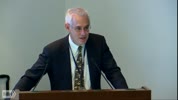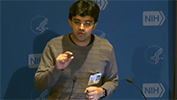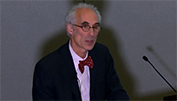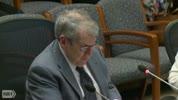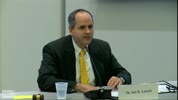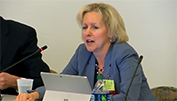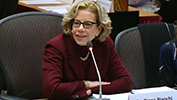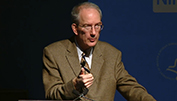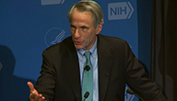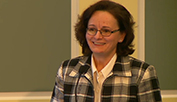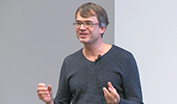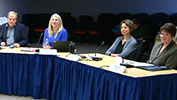-
- NIH VideoCast - Division of Allergy, Immunology and Transplantation Subcommittee - January 2017
-
- - NIAID, NIH (2017/02/04)
- - Category : National Institute of Allergy and Infectious Diseases
- Report from Division Director and Division Staff
NIH VideoCast - Division of Allergy, Immunology and Transplantation Subcommittee - January 2017
-
- NIH VideoCast - Learning the ???metadata??? of the cell with single cell genomics and Seurat
-
- - Rahul Satija, D.Phil, New York Genome Center and NYU Center for Genomics and System Biology (2017/02/04)
- - Category : Special
- NIH Single Cell Analysis Lecture Series
Dr. Satija`s group brings cutting-edge analysis tools such as the package "Seurat" to help us understand cell heterogeneity in complex biological systems. The creative insight and innovative tools developed by the Satija group and colleagues help in handling highly multi-dimensional single cell genomics datasets, and have been recently utilized in many groundbreaking, high-throughput single cell RNA-Seq publications.
This seminar is sponsored by NCI-CCR, with organizational support from the Single Cell Genomics, Bioinformatics and Data Science Special Interest Groups.
NIH VideoCast - Learning the ???metadata??? of the cell with single cell genomics and Seurat
-
- NIH VideoCast - Bone Marrow Aging and the PTH Receptor: A Model of Integrative Physiology
-
- - Dr. Clifford J Rosen, Senior Scientist and Director of the Center for Clinical and Translational Research, Maine Medical Center Research Institute (2017/02/04)
- - Category : Geroscience
- Trans-NIH GeroScience Interest Group (GSIG)
Dr. Cliff Rosen is a Senior Scientist and the Director of the Center for Clinical and Translational Research at the Maine Medical Center Research Institute (MMCRI). His laboratory studies the mesenchymal stem cell fate as it relates to the switch between pre-adipocytes and pre-osteoblasts. The focus of these efforts relates to cell autonomous factors such as substrate utilization and bioenergetics of the osteoblast and cell non-autonomous determinants such as parathyroid hormone and sympathetic tone. Dr. Rosen???s current projects, supported by the NIH, revolve around the origin and function of bone marrow fat cells; the role of IGFBP-2 in osteogenesis and the bioenergetics of the osteoblast; the impact of anabolic therapy for age-related osteoporosis on marrow adipose tissue; and whole body and cell phenotyping related to metabolic function in mice. Dr. Rosen is the past president of the American Society of Bone and Mineral Research. He served as an associate editor at Journal of Clinical Endocrinology and Metabolism, senior associate editor at the Journal of Bone and Mineral Research and Aging Cell. He is currently an Associate Editor at New England Journal of Medicine and eLife.
The GSIG was created to discuss and explore the complex relationships between the biology of aging and the biology of diseases and conditions that are of interest to various institutes and centers across the NIH. If you are interested in learning more, please visit the GSIG web site http://sigs.nih.gov/geroscience/Pages/default.axsp
NIH VideoCast - Bone Marrow Aging and the PTH Receptor: A Model of Integrative Physiology
-
- NIH VideoCast - NIAMS Advisory Council - January 2017
-
- - NIAMS, NIH (2017/02/03)
- - Category : Advisory Board Meetings and Workshops
- 91st Meeting of the NIAMS Advisory Council.
Stephen I. Katz, M.D., Ph.D., Chair.
For more information go to http://www.niams.nih.gov/About_Us/Committees/council_roster.asp
NIH VideoCast - NIAMS Advisory Council - January 2017
-
- NIH VideoCast - NIGMS Council Open Session - January 2017
-
- - NIGMS, NIH (2017/02/03)
- - Category : Advisory Board Meetings and Workshops
- This is the public broadcast of the NIGMS Jan 2017 Open Session for Council
NIH VideoCast - NIGMS Council Open Session - January 2017
-
- NIH VideoCast - NIAID Advisory Council Meeting - January 2017
-
- - NIAID, NIH (2017/02/03)
- - Category : National Institute of Allergy and Infectious Diseases
- Dr. Anthony S. Fauci will address the full council. Dr. Maureen Goodenow will address the full council.
NIH VideoCast - NIAID Advisory Council Meeting - January 2017
-
- NIH VideoCast - AIDS Research Advisory Committee - January 2017
-
- - Division of AIDS, NIAID, NIH (2017/02/03)
- - Category : AIDS Research Advisory Committee
- January 30, 2017 AIDS Research Advisory Committee Meeting
NIH VideoCast - AIDS Research Advisory Committee - January 2017
-
- NIH VideoCast - Division of Microbiology and Infectious Diseases Subcommittee - January 2017
-
- - NIAID, NIH (2017/02/03)
- - Category : National Institute of Allergy and Infectious Diseases
- Report from Division Director and Division Staff
NIH VideoCast - Division of Microbiology and Infectious Diseases Subcommittee - January 2017
-
- NIH VideoCast - NICHD Advisory Council Meeting - January 2017
-
- - NICHD, NIH (2017/02/03)
- - Category : National Institute of Child Health and Human Development
- To help achieve the goals of the Institute, the NACHHD Council is charged with advising, consulting with, and making recommendations to the NICHD director on matters relating to the research and research support activities and functions of the Institute.
NIH VideoCast - NICHD Advisory Council Meeting - January 2017
-
- NIH VideoCast - Ethics Rounds: Offering Patients Innovative Therapy: When Is It a Good Idea?
-
- - Jeremy Sugarman, MD, MPH, MA ,Harvey M. Meyerhoff Professor of Bioethics and Medicine, Professor of Medicine, Professor of Health Policy and Management, and Deputy Director for Medicine, Johns Hopkins Berman Institute of Bioethics (2017/02/03)
- - Category : Clinical Center Grand Rounds
- Ethics Rounds: Offering Patients Innovative Therapy: When Is It a Good Idea?
For more information go to http://www.cc.nih.gov/about/news/grcurrent.html
NIH VideoCast - Ethics Rounds: Offering Patients Innovative Therapy: When Is It a Good Idea?
-
- NIH VideoCast - OAR Listening Day - February 2017
-
- - Dr. Gina Brown, NIAID, NIH (2017/02/03)
- - Category : National Institute of Allergy and Infectious Diseases
- The Office of AIDS Research (OAR), located within the National Institutes of Health (NIH), Office of the Director, Division of Program Coordination, Planning, and Strategic Initiatives (DPCPSI), coordinates the scientific, budgetary, legislative, and policy elements of NIH HIV/AIDS research. During the OAR Listening Day, participants will meet the Director of the Office of AIDS Research and with OAR staff and colleagues to share their thoughts about HIV/AIDS research.
NIH VideoCast - OAR Listening Day - February 2017
-
- NIH VideoCast - Therapy of lymphoma inspired by functional and structural genomics
-
- - Louis M. Staudt, M.D., Ph.D., Director, Center for Cancer Genomics, National Cancer Institute, NIH (2017/02/03)
- - Category : WALS - Wednesday Afternoon Lectures
- Wednesday Afternoon Lecture Series
Dr. Staudt`s laboratory uses genomic technologies to discover molecular subtypes of cancer and develop therapies that target oncogenic regulatory pathways in each subtype. This endeavor is now commonly known as precision medicine and is the direct fruit of the Human Genome Project.
The Staudt laboratory has designed the "Lymphochip," a custom DNA microarray that profiles gene expression in normal lymphocytes as well as in malignant lymphomas and leukemias. His laboratory defined two dominant molecular subtypes of the most common form of non-Hodgkin lymphoma???diffuse large B-cell lymphoma (DLBCL)???and showed that they arise from distinct stages of normal B-cell differentiation, utilize different oncogenic mechanisms, and respond differently to therapy. These subtypes, termed activated B-cell-like (ABC) and germinal center B-cell-like (GCB), are now recognized as distinct diseases. The laboratory has used functional genomics methods (RNAi and CRISPR-Cas9 screens) and structural genomics methods (e.g. cancer gene resequencing) to identify essential regulatory pathways that drive the malignant proliferation and survival of these lymphomas, thereby identifying potential therapeutic targets. For ABC DLBCL, the Staudt laboratory defined a ???chronic active??? form of B-cell receptor (BCR) signaling that activates the pro-survival NF-kB pathway. Over one fifth of ABC DLBCLs have mutations affecting the CD79B or CD79A subunits of the BCR, which augment BCR signaling. To attack chronic active BCR signaling therapeutically, the Staudt laboratory initiated clinical trials in relapsed/refractory DLBCL of ibrutinib, a drug used to treat B-cell cancers. Ibrutinib is an irreversible and highly selective inhibitor of the BTK, a key kinase that is required for BCR-dependent NF-kB activation. Monotherapy with ibrutinib induced a high rate of complete and partial responses in ABC DLBCL, while GCB DLBCL tumors rarely responded. When the tumors were genomically analyzed, the scientists found that patients with mutations in the BCR together with mutations in the signaling adapter MYD88 had the highest response rate. This clinical observation led Dr. Staudt`s laboratory to delineate molecular mechanisms by which MYD88 augments BCR-dependent NF-kB activation. Based on this knowledge, Dr. Staudt has recently conducted clinical studies in primary central nervous system lymphoma, an aggressive cancer with an ABC gene expression profile and very frequent mutations in the BCR and MYD88. For his lecture, Dr. Staudt will present encouraging responses to ibrutinib alone and in combination with chemotherapy in patients with relapsed and refractory disease.
About the G. Burroughs Mider lecture:
Established in 1968 in honor of the first NIH director of laboratories and clinics, this lecture is part of the Wednesday Afternoon Lecture Series. It is presented by an NIH intramural scientist in recognition of and appreciation for his or her outstanding contributions to biomedical research.
For more information go to https://oir.nih.gov/wals/2016-2017/therapy-lymphoma-inspired-functional-structural-genomics
NIH VideoCast - Therapy of lymphoma inspired by functional and structural genomics
-
- NIH VideoCast - Curing HIV infection: going beyond N=1
-
- - Robert F. Siliciano, MD, PhD, Johns Hopkins School of Medicine (2017/02/03)
- - Category : Immunology
- Immunology Interest Group Seminar Series
The latent reservoir for HIV is a major barrier to curing HIV infection. This talk will discuss recent studies of the mechanism by which the reservoir arises, the mechanism by which it is maintained, and approaches for measuring the reservoir in patients participating in HIV cure trials.
Dr. Robert F. Siliciano is a Professor of Medicine and Molecular Biology and Genetics at the Johns Hopkins University School of Medicine and a member of the Howard Hughes Medical Institute. In 1995, his laboratory provided the first demonstration that latently infected memory CD4+ T cells were present in patients with HIV-1 infection. He showed that latently infected cells persist even in patients on prolonged antiretroviral therapy (ART). These studies indicated that eradication of HIV-1 infection with ART alone would never be possible, a finding which led to a fundamental change in the treatment strategy for HIV-1 infection. This latent reservoir is now recognized as the major barrier to curing HIV-1 infection and is the subject of an intense international research effort. Dr. Siliciano???s laboratory has gone on to characterize the reservoir and to explore strategies for eradicating it. In addition, Dr. Siliciano has developed a theoretical foundation for understanding the success of ART in controlling HIV-1 replication.
Dr. Siliciano graduated from Princeton and received his MD and PhD degrees from Johns Hopkins. After a postdoctoral fellowship at Harvard, he joined the Hopkins faculty. He has received the Distinguished Clinical Scientist Award from the Doris Duke Charitable Foundation and two NIH Merit Awards. He is a past Chairman of the NIH AIDS and Related Research Study Section. For 16 years, he directed the Hopkins MD-PhD Program, and he now serves as an advisor for MDPhD students. In 2008, he received a major award in AIDS research, the Bernard N. Fields Memorial Lecture at the Conference for Retroviruses and Opportunistic Infections.
NIH VideoCast - Curing HIV infection: going beyond N=1
-
- NIH VideoCast - NIH Council of Councils Meeting - January 2017
-
- - NIH (2017/02/02)
- - Category : Council of Councils
- The NIH Council of Councils advises the NIH Director on on the policies and activities of the Division of Program Coordination, Planning, and Strategic Initiatives in the Office of the Director, NIH. The Council also carries out concept clearance for grant programs proposed by the DPCPSI Office of Research Infrastructure Programs (ORIP) and the NIH Common Fund, and conducts second-level review of proposed ORIP grant awards, awards for the Common Fund Transformative Research Award and Early Independence Award Programs, and awards for the Environmental Influences on Child Health Outcomes and Precision Medicine Initiatives Programs.
For more information go to https://dpcpsi.nih.gov/council/index
NIH VideoCast - NIH Council of Councils Meeting - January 2017
-
- NIH VideoCast - Molecular mechanisms of synapse assembly and maturation
-
- - Michaela Serpe, Ph.D., Senior Investigator, Section on Cellular Communication, NICHD, NIH (2017/02/02)
- - Category : NIH Director`s Seminars
- Director`s Seminar Series
The Section on Cellular Communication is interested in understanding how chemical synapses are assembled and sculpted during development and homeostasis. We focus on glutamatergic synapse development, in particular on the role of cell-cell communication in the initial clustering of receptors and formation of functional synapses, and in their fine-tuning during plasticity. Many neurological disorders are linked with defects in synaptogenesis; however, the initial clustering functions are poorly understood. We address these fundamental issues using a powerful genetic system, Drosophila melanogaster, and a comprehensive set of approaches including genetics, biochemistry, molecular and cellular biology, and electrophysiology. We have recently identified a key auxiliary protein for glutamatergic synapses, called Neto, that is essential for synapse development and function both in Drosophila and mammals. Our studies demonstrate that trafficking of glutamate receptor subtypes on the cell membrane, their synaptic recruitment and stabilization, and their function are tightly regulated by Neto. Neto also appears to be at the center of trans-synaptic complexes that monitor the synapse activity status and relay this information to the pre- and post-synaptic compartments. On the presynaptic site, we discovered that Neto engages a completely novel BMP signaling modality that enables BMPs to monitor synapse activity and coordinate it with synapse growth and maturation.
NIH VideoCast - Molecular mechanisms of synapse assembly and maturation
-
- NIH VideoCast - Evolution of Neurons and Nervous System: A Cell Type Perspective
-
- - Detlev Arendt, Ph.D., Group Leader, Senior Scientist and Academic Postdoctoral Mentor, Developmental Biology Department, European Molecular Biology Laboratory (2017/02/02)
- - Category : Neuroscience
- NIH Neuroscience Series Seminar
Dr. Arendt Group is intrigued by one of the remaining great mysteries in animal evolution: how did our central nervous system (CNS) come into existence? What did it look like at first and how did it function? They are especially interested in the CNS of an extinct animal known as Urbilateria, the last common ancestor of humans, flies and most other ???higher??? animals that live today, which lived some 600 million years ago in the ocean.
Dr. Arendt lab has chosen to investigate a new molecular animal model, the marine annelid Platynereis dumerilii. As a ???living fossil???, Platynereis represents an ideal connecting link between vertebrates and the fast evolving protostome models, Drosophila and Caenorhabditis. Platynereis is amenable to high throughput imaging techniques and functional interference approaches, for example the first genetic knockout lines have been generated. With the recent development of the PrImR (Profiling by Image Registration) resource, Platynereis has become the first animal model for which gene expression profiling data can be obtained in cellular resolution for the whole organism. Dr. Arendt Group has discovered that their brains harbour sensory-associative parts and a neurosecretory centre that corresponds to the vertebrate pallium and hypothalamus, respectively. A clear picture is emerging that the Platynereis brain harbours many cell types so far known only for vertebrates, but in a much simpler and different overall arrangement, revolutionising our current understanding of brain evolution.
To broaden their comparative approach, they have introduced two new model species to the lab, the lancelet amphioxus and the sea anemone Nematostella, representing distinct divisions of the animal kingdom: chordates and cnidarians. Amphioxus has a very simple brain uniting invertebrate- and vertebrate-like features. The Nematostella nervous system is very simple and is a good proxy for an early stage of nervous system evolution. Their aim is to gain a systems view of the Platynereis brain and nervous system and to track the evolutionary history of all constituent cell types by identifying and investigating their evolutionary counterparts in sea anemone and amphioxus. This will involve investigations of cell type-specific gene regulatory networks in all species as well as neurobiological and behavioural approaches.
For more information go to https://neuroscience.nih.gov/neuroseries/Home
NIH VideoCast - Evolution of Neurons and Nervous System: A Cell Type Perspective
-
- NIH VideoCast - Demystifying Medicine 2017: Glycoproteins, Allergy, and Other Diseases
-
- - John Hanover, PhD, NIDDK, NIH, Michelle Bond, PhD, NIDDK, NIH and Jonathan Lyons, MD, NIAID, NIH (2017/02/02)
- - Category : Demystifying Medicine
- The Demystifying Medicine Lecture Series is designed to help bridge the gap between advances in biology and their applications to major human diseases. Each lecture will feature a presentation on a major disease, including current research and advancements on treatments.
For more information go to https://demystifyingmedicine.od.nih.gov/
NIH VideoCast - Demystifying Medicine 2017: Glycoproteins, Allergy, and Other Diseases
-
- NIH VideoCast - Human pluripotent stem cells in understanding genetic cardiovascular disease and effects of drugs
-
- - Christine Mummery, Ph.D, Professor, Department of Anatomy and Embryology, Leiden University Medical Centre, The Netherlands (2017/01/27)
- - Category : WALS - Wednesday Afternoon Lectures
- NIH Director???s Wednesday Afternoon Lecture Series
There`s a growing interest in how the derivation of many different cell types from human pluripotent stem cells-embryonic stem cells (HESCs) and induced pluripotent stem cells (hiPS cells)-could be used for potential cell therapy and as a platform for drug discovery and toxicity. In particular, new methods of introducing specific disease mutations into human pluripotent stem cells and/or reprogramming them to derive hiPS cells, allow the creation of disease models "in a dish" so scientists can study ways to treat diseases or slow them down. To move the field forward, it`s essential that scientists understand the underlying developmental mechanisms that control differentiation of pluripotent cells to their derivatives and mimic these in conditions in vitro. The Mummery lab has used these methods to produce isogenic pairs of hiPSC lines to compare diseased and corresponding control cardiomyocytes and vascular endothelial cells and identify disease-related phenotypes and mechanisms. The lab has also examined how hESC-derived cardiomyocytes respond to a variety of cardiac and non-cardiac drugs and has shown that iPSC-derived cardiomyocytes with mutations in ion-channel genes can accurately predict changes in cardiac electrical properties and reveal drug sensitivities. Dr. Mummery will describe similar studies that use vascular endothelial cells from hPSC and discuss the appropriate bioassays to measure disease phenotypes.
For more information go to https://oir.nih.gov/wals
NIH VideoCast - Human pluripotent stem cells in understanding genetic cardiovascular disease and effects of drugs
-
- NIH VideoCast - Group 1 innate lymphoid cells in metabolic disease
-
- - Joseph C. Sun, Ph.D., Memorial Sloan Kettering Cancer Center (2017/01/27)
- - Category : Immunology
- Immunology Interest Group Seminar Series
Innate lymphoid cells (ILCs) are the most recently identified arm of the innate immune system that function to protect epithelial barriers against pathogens and maintain tissue homeostasis. Although ILCs can also promote pathology at mucosal sites such as the gut or lung, it remains unknown whether aberrant activation of tissue-resident ILCs can contribute to disease in non-barrier tissues. Here, we identify a subset of long-term adipose-resident ILC1 that are dependent on the transcription factors Nfil3 and T-bet, but phenotypically and functionally distinct from circulating mature natural killer cells. Diet-induced obesity drove early proinflammatory cytokine production in adipose tissue depots, leading to selective proliferation and accumulation of adipose-resident ILC1s. ILC1-derived IFN-?? was both necessary and sufficient to drive proinflammatory macrophage polarization to promote obesity-associated insulin resistance. Therefore, these findings suggest that adipose-resident ILC1s contribute to metabolic disease in response to dysregulated local inflammation.
Dr. Joseph Sun obtained his Ph.D. degree from the Department of Immunology, University of Washington, where he worked in Dr. Michael Bevan???s laboratory on the role of CD4 T cells in the generation and maintenance of CD8 T cell memory. He then received his postdoctoral training in the Department of Microbiology and Immunology, UCSF, with Dr. Lewis L. Lanier, where he discovered NK cell ???memory???. In 2010, Joe was recruited as an Assistant Member, to the Immunology Program, Memorial Sloan Kettering Cancer Center, New York, NY. Joe continued to pursue his interests in both immunological memory and NK cell biology. This body of work includes all facets of NK cell biology, from development to function to longevity. A seminal work from his lab demonstrated the critical function of RAG recombinase in dictating NK cell development, effector function, and survival. Joe has been highly productive, and was promoted to Associate Member last year.
NIH VideoCast - Group 1 innate lymphoid cells in metabolic disease
-
- NIH VideoCast - RFA RM-16-019: NIH Health Care Systems Research Collaboratory - Demonstration Projects for Pragmatic Clinical Trials (UG3/UH3)
-
- - Robin Boineau, NIH, Marcel Salive, NIH, Martinia Schmits, NIH and Shelly Carow, NIH (2017/01/26)
- - Category : Special
- During the videocast, FOA contacts will review the purpose and objectives of the FOA and address questions from the community.
NIH VideoCast - RFA RM-16-019: NIH Health Care Systems Research Collaboratory - Demonstration Projects for Pragmatic Clinical Trials (UG3/UH3)



